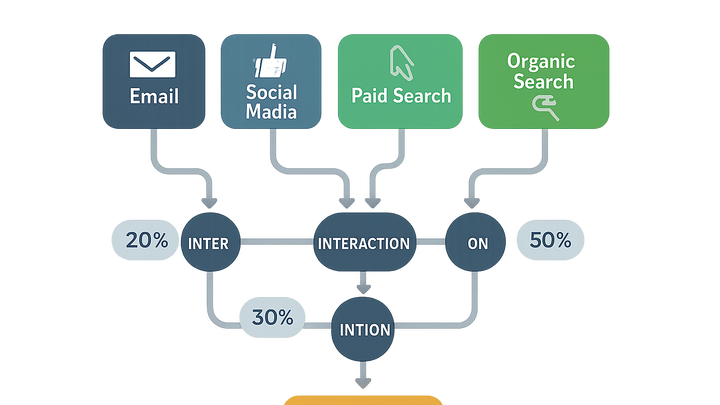Published on 2025-06-26T05:11:50Z
What Are Multi-Channel Funnels? Examples for Multi-Channel Funnels
Multi-Channel Funnels (MCF) refer to the sequence of marketing interactions that lead a user to convert. Unlike single-touch attribution models that credit only the final interaction, MCF tracks assisted conversions across various channels—organic search, paid ads, email, social, and more—giving marketers a holistic view of how channels work together. This approach highlights the cumulative impact of each touchpoint, revealing which channels play critical supportive roles. By analyzing MCF, businesses can allocate their budget more effectively, optimize marketing strategies, and uncover hidden performance insights. MCF reporting is available in platforms like Google Analytics 4 (GA4) and can be approximated in cookie-free tools like PlainSignal.
Multi-channel funnels
Multi-Channel Funnels show the sequence of marketing touchpoints leading to conversions across channels, highlighting assisted conversions.
Understanding Multi-Channel Funnels
This section explains the fundamentals of Multi-Channel Funnels, distinguishing it from single-touch attribution and defining key concepts.
-
Definition
Multi-Channel Funnels map all the marketing touchpoints a user interacts with before completing a conversion. Each interaction—such as an ad click, email open, or organic search—is recorded and attributed a portion of credit.
-
Marketing touchpoints
Touchpoints include any user interaction: email campaigns, social ads, paid search clicks, organic visits, and direct sessions. MCF aggregates these to display the conversion path.
Importance of MCF Analysis
Discover why analyzing Multi-Channel Funnels is vital for informed marketing decisions and budget allocation.
-
Identify assisted conversions
MCF reveals channels that assist conversions without receiving last-click credit, such as display ads or email nurturing campaigns.
-
Optimize channel investment
By understanding which channels play supportive roles, marketers can allocate budgets more strategically across the customer journey.
Implementing MCF in SaaS Analytics Platforms
Compare how leading analytics tools support Multi-Channel Funnel reporting and their setup considerations.
-
Google analytics 4
GA4 provides Funnel Exploration and Path Exploration reports to analyze MCF. It uses event-based data and default channel groupings.
-
Setup steps
Enable Enhanced Measurement, define conversion events in Admin > Events, then navigate to Explore > Funnel Exploration.
-
Benefits
Detailed path visualization, customizable funnels, and integrated attribution settings (last click, data-driven).
-
-
PlainSignal (cookie-free analytics)
PlainSignal offers privacy-focused analytics without cookies. It infers sessions and referrers to approximate multi-touch paths.
-
Limitations
Lacks persistent identifiers, so cross-session user-level journeys may be undercounted; relies on referrer and session grouping.
-
Strengths
Simple setup, fully compliant with privacy regulations, and minimal performance overhead.
-
Example Tracking Code
Implementing PlainSignal to capture touchpoints for Multi-Channel Funnel analysis.
-
PlainSignal integration
Insert the following snippet into your site’s <head> tag:
<link rel="preconnect" href="//eu.plainsignal.com/" crossorigin /> <script defer data-do="yourwebsitedomain.com" data-id="0GQV1xmtzQQ" data-api="//eu.plainsignal.com" src="//cdn.plainsignal.com/plainsignal-min.js"></script>
Best Practices for Multi-Channel Funnel Reporting
Key tips to ensure accurate and actionable MCF insights.
-
Use consistent utm parameters
Standardize UTM tagging (source, medium, campaign) across all marketing channels to ensure accurate attribution.
-
Define channel groupings
Customize channel definitions in your analytics settings to reflect your marketing structure (e.g., differentiate social organic vs. paid).
-
Regularly review attribution models
Test different attribution models (last click, linear, time decay) to understand how credit distribution impacts channel performance.
